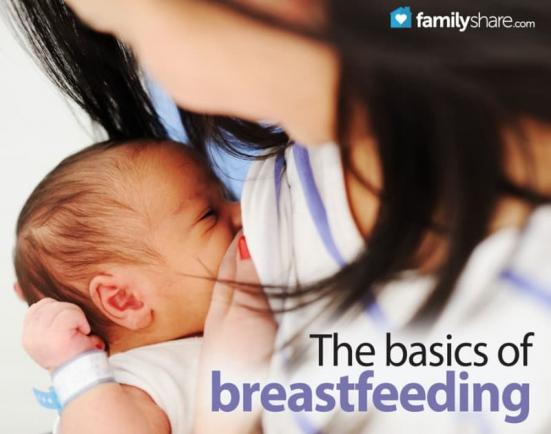
How to feed a baby is a personal decision. However, when a mother chooses to breastfeed, it's important to know what to expect. Here are the basics of breastfeeding.
In the hospital
Having a good start to breastfeeding is essential for success. The best advice I got about breastfeeding was from my mom. She told me that when I was in the hospital, I should ask for a nurse to help me each time I tried to nurse my baby to make sure he was latching on correctly. This helped a lot. I left the hospital feeling very confident. The nurses are there to help you, so don't hesitate to ask. If the hospital has a trained lactation consultant on-staff, it is worth it to visit with them, as well.
The first few months
The first few weeks (or months!) can be difficult. It takes a while for the breast milk supply to regulate, and this may cause discomfort. To help with engorgement, invest in a breast pump. There will be times when your baby isn't hungry. However, you will want to empty your breasts to relieve that discomfort. Pumping will solve this, and will help create a supply of breast milk to freeze.
Another good investment is nursing bras. Going to a store that specializes in maternity wear, such as Motherhood Maternity, is a good idea. The sales associates are trained to help mothers find the perfect fit. Getting a nursing bra with no underwire is usually recommended, because underwire can lead to blocked ducts. I was told to get two-to-three regular nursing bras, and two for sleeping.
Other essentials in the first few months are nursing pads and some kind of nipple cream, such as Lasionoh lanolin. As your breast milk is regulating, nursing pads will help prevent embarrassing milk leaking situations. The lanolin will help alleviate pain.
There are many people who want to help mothers succeed in breastfeeding. There are plenty of lactation consultants available. Services such as Women, Infants, and Children (WIC) offer free breastfeeding help.
Introducing solids
As soon as a baby starts eating, the weaning process begins. However, it is important to remember that solid foods should not replace breast milk until the child is at least 1 year old. According to KellyMom.com, no more than 25 percent of an infant's caloric intake should come from solid foods until after a year, if possible.
When introducing solids, try offering breast milk as the first choice, then follow with solid food. This will ensure a breast milk supply stays steady, and that baby is getting the nutrients she still needs from breast milk.
Weaning
This can be a touchy subject. When should a mother wean her child? Some say the day they turn one, others say, continue until the child decides to self-wean. To be honest, I think that's a personal decision that no one can make but the parent. However, when a mother chooses to wean her child, there are a few different methods.
Intermountain Moms, a service run by Intermountain Healthcare, suggests the three ways to wean are:
Gradual weaning
Dropping one feeding every few days (or even longer), and replacing with cow's milk. This can be easier because it's not such an abrupt change for the child, and it allows for a mother's milk supply.
Partial weaning
Eliminating one feeding, but still continuing other feedings regularly.
Abrupt weaning
This involves just completely cutting out breastfeeding.
Another method, according to Kelly Mom, is to use the "Don't offer, Don't refuse" approach. This is a slow-moving weaning process. However, it is also the easiest on the child.
Here are a few other tips:
Nursing strike
Some babies will go through what is known as a "nursing strike." This is when they refuse to nurse. This is normal and will typically pass within a few days. This tends to happen around milestone times, where the baby is more interested in practicing new skills than nursing. Not all babies will have nursing strikes. It's important to remember that before about 18 months, most children will not self-wean, so if your baby is refusing to nurse, especially in the first year of life, it is not because they are weaning themselves. This website offers some excellent tips on how to survive a nursing strike.
Increased desire
I've heard many moms talk about how all of a sudden, their baby wants to nurse all the time. Most of those moms also worry that their baby is starving. Rest assured, they probably aren't. While some mothers may have a low breast milk supply, so their child isn't getting enough, this usually isn't the case. According to KellyMom, most babies experience growth spurts between 7 and 10 days, 2-3 weeks, 4-6 weeks, 3 months, 4 months, 6 months, and 9 months. These only last a few days, but sometimes may last up to a week. You may feel like a slave to your baby during these times, but they do pass quickly. If your child is younger than 6 months, it may be tempting to start the baby on solid foods. This should not be done without consulting with the child's pediatrician, especially before the age of 4 months.
Positions
There are quite a few different nursing positions. Experiment with all of them to see which works best for you and your baby. BabyCenter.com describes some of the different positions in detail here. However, here are some brief descriptions:
Cradle hold
Cradling the baby's head in the crook of your arm
Cross-over
Similar to the cradle hold, but you hold the baby's head with your hands
Clutch or football hold
Tuck the baby under your arm
Reclining
Laying down with baby facing toward you
Whichever position you choose, always make sure the baby's air pathway is clear and not cut off. Whatever your decision in feeding your baby, enjoy these moments with your young one.

